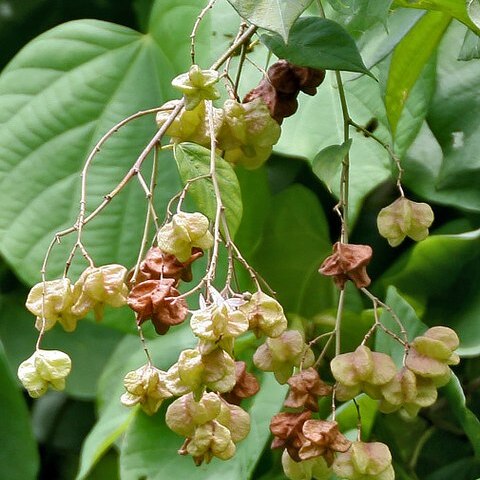Trees, up to 12 m tall; bark gray, exfoliate. Branchlets gray-green, sparsely pilose. Petiole 3-5.5 cm; leaf blade broadly ovate or ovate, 5.5-18 × 5.5-18 cm, abaxially puberulent when young, adaxially glabrous, base cordate or subcordate, entire or sparsely dentate in upper part, apex acuminate or acute. Inflorescence a thyrse, to 50 cm, hairy. Flowers dense. Sepals pink, petaloid, ca. 6 mm. Petals pink, shorter than sepals, 1-cucullate, yellow at apex, shorter than others. Androgynophore long, hairy. Ovary globose, hairy, usually only 1 ovule developed in each locule; style glabrous. Capsule broadly pyriform to almost globose, 5-angled, 1-1.7 cm, greenish pink when mature, pendulous. Seeds globose, 1.5-2 mm in diam., black or dark brown. Fl. Mar-Jul.
A medium sized tree with a round dense crown and the trunk often has buttresses and suckers at the base. It can grow 3-15 m high. The young twigs are velvety. The leaves are simple, oval and alternate. They are thin and paler beneath. They are hairless but the young ones are finely woolly. The leaves are up to 20 cm long by 15 cm wide. The leaf stalks can be 10 cm long. It produces sprays of pink flowers at the ends of the branches. The flowers are small and finely woolly on the inside. The fruit is a pinkish brown five shouldered capsule. The capsule is like a pliable sheet and hangs down. It is inflated and an irregular oval shape. The seeds are round and brown and roughened with abnormal growths. There are 1 or 2 seeds in each cell.


